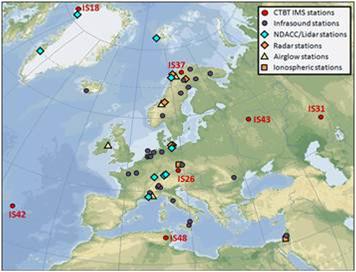ARISE infrastructure concept
ARISE infrastructure composed of
- Infrasound, LIDAR and mesospheric observation networks
- Monitoring stations for the observation of volcanic sources, equatorial and tropical atmospheric waves, and the coupling between the atmosphere and near Earth space (ionospheric stations).
The ARISE Design Study project proposes to design a new infrastructure that integrates different atmospheric observation networks to provide a new 3D image of the atmosphere in the different atmospheric layers from ground to mesosphere with unprecedented spatio-temporal resolution. The infrastructure coverage will be Europe and outlying regions, including polar and equatorial regions.
The implied networks are the infrasound network developed for verification Comprehensive Nuclear-Test-Ban Treaty (CTBT) completed by the European infrasound network composed of national stations and networks, the Network for the Detection of Atmospheric Composition Changes (NDACC) using LIDAR (LIght Detection And Ranging) and complementary meteor and MST radars, wind radiometers, infrasound stations located near volcanoes for volcanic sources studies, ionospheric sounding arrays to determine coupling with near Earth space and satellite observations. A strong synergy is also established with the European Incoherent Scatter Scientific Association (EISCAT ).
The ARISE project aims to revive existing collaborations among European scientists while developing and integrating, for the first time, a large set of complementary topics such as infrasound, gravity and planetary waves, stratosphere and mesosphere disturbances, satellite atmospheric studies and modelling of the atmosphere, and atmospheric dynamics. Data collected by these multiple networks will be analyzed to extract optimized estimation of the evolving state of different atmospheric layers, which would help to constrain the parameterization of gravity waves and to better initialize forecasts of the middle and upper atmosphere.
The expected benefits would be a better description of the atmosphere and an improved accuracy in short- and medium-range weather forecasts. ARISE measurements will also be used to improve the representation of gravity waves in stratosphere-resolving climate models, crucial to estimating the impact of a range of stratospheric climate forcing on the troposphere. In the long term, the data will be used for monitoring of middle atmosphere climate, its long-term mean trends and changes in extreme events. The benefits also include civil applications related to monitoring of natural hazards

 ARISE Home
ARISE Home ARISE Data Center
ARISE Data Center
